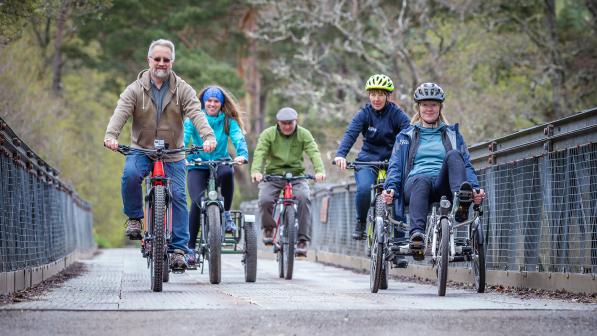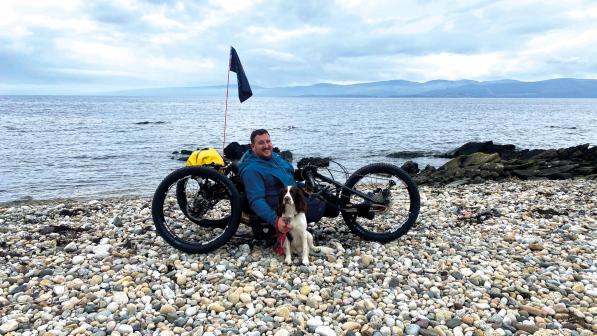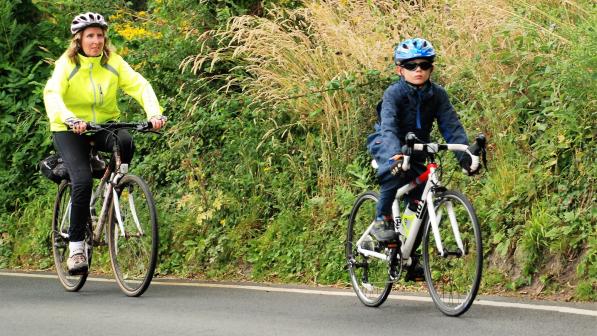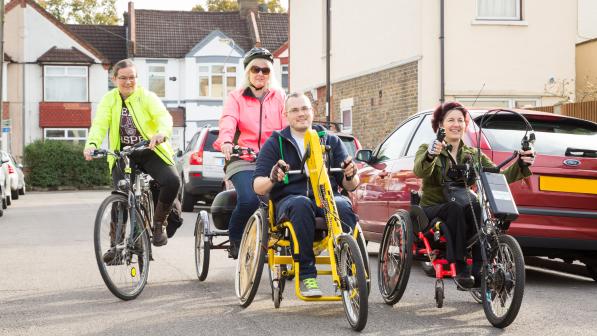Feature: Active Travel for all?

Our family is part of the tiny fraction of the population who use cycling for transport while having disabled adults and disabled children in the household. I have arthritis in my back, which makes walking difficult and pretty much everything painful. I use crutches to walk short distances – yet can ride across the city on my e-bike.
Two of our children have ADHD and autism. Additionally, our daughter is also learning disabled and attends a special school. Yet they are the only pupils at their schools who regularly cycle there (always with me). We think this gives us some insight into why most disabled people don’t use active travel.
Before looking at the barriers disabled cyclists face, let’s look at the scale of the problem: 22% of people in the UK are disabled, according to the Government’s latest UK family resources survey. Disabled people are about 50% more likely to be inactive than non-disabled people (source: Sport England). That’s not because they don’t want to be active. While 84% of disabled people never cycle, a third of disabled people who currently don’t cycle want to do so.
Crunching these numbers reveals that around 6% of the UK’s population are disabled people who want to cycle. And that doesn’t include the disabled people who’d walk more or get about by mobility scooter or wheelchair if they could. So what’s stopping all these people getting onto the streets, particularly on bikes?

Barrier #1: the cost
This is the least of the problems would-be disabled cyclists face but it’s not insignificant. We use a Circe Helios STEPS tandem, which has electric assistance. I can’t ride without a motor for extra power and our daughter can’t steer or brake reliably so it’s the least-specialist cycle we can use.
Its retail price is £4,700, which is more than three-and-a-half years of the lower mobility component of the disability living allowance. It’s a heck of a punt if you’re not really sure you’re going to use the bike a lot. Prices can be even higher for more complex cycles. As disabled people are more likely to live in poverty than non-disabled people, splashing out thousands of pounds on a specialist cycle is out of the question for most.
We ride over 100km each week on the tandem. It’s much cheaper per mile than a car and more convenient too: we can usually ride door to door, minimising my need to walk and our children’s need to cope with busy car parks. It’s also faster for urban journeys than a car, even allowing for low-strength riding. And of course it’s better for our health and for the environment. It’s better for drivers as well as we’re not blocking up the road with another big vehicle.
But then there’s another barrier…

Barrier #2: no everyday cycling experience
It’s almost impossible to get everyday cycling experience when you’re disabled. So how do you go from being a non-cycling disabled person to becoming a disabled cyclist who is able to get to the places you need to go? Pottering about at a disability taster session is not the same as useful riding – the kind of cycling where you can set off to a destination with minimal planning and be able to get there reliably, as you could in a car.
Most of us disabled adults have families, jobs, and other responsibilities, never mind the basic ‘get food, get prescriptions, get to appointments, keep the household running’ routine we all share. Unless you’re already confident using a cycle, simply finding time to learn and introduce cycling into your daily life is going to be a gigantic hurdle.
If you’re an adult with disabled children, working out how to get places even in a car can be enough of a struggle. Figuring out how to teach road safety and cycling skills to someone with additional needs can be another massive barrier, especially if you’re having to consider how their additional needs will interact with your own.
An example: we had long period in which one child would have a meltdown at pedestrian crossings whenever we couldn’t cross on our green man. We live near a hospital so ambulances often zoom down this road… This meltdown risk made every walk more stressful than it would have been for a non-disabled family. It made cycling impossible because a child can leap off a bike and run if upset, and when your hands are on the handlebar you can’t hold onto them.
We’ve been very lucky in our ability to access active travel while disabled. That’s mainly because we were able to take our learning in small steps. I wasn’t disabled when we first had kids, and like my partner I’ve been a keen cyclist all my life. Our older two children aren’t disabled, and I was a childminder when they were little. So I’ve had years of practice as an able-bodied adult hauling various sizes and numbers of children around using cycle trailers, tag-a-longs (the tandem tag-a-long got a lot of comments), and solo bikes. When we had disabled children and I became disabled myself, we already had lots of experience of active travel.
Even so, we had quite a few years when cycling our regular journeys wasn’t an option. Not because I couldn’t ride. Not because the kids couldn’t ride either. It was something else…

Barrier #3: bad infrastructure
The biggest barrier to active travel is bad infrastructure. In most places the streets, tracks, crossings and cycle paths are just not accessible enough to allow disabled people to choose walking, rolling or cycling for their journeys.
For disabled pedestrians, potholed and sloping pavements blocked with badly parked vehicles and blown bins, littered with dog poo and broken glass, lead you to crossings that change from green to red too fast for you. If you’re in a powered wheelchair or using a mobility scooter, you might make it over a crossing fast enough.
For disabled cyclists an extra delight is that you’re supposed to be on the road most of the time. Potholes and badly-installed dropped kerbs can really hurt. Car-obstructed dropped kerbs can end a ride; for many disabled people, a full-height kerb may as well be a six-foot wall. Then there are the chicanes, the literal barriers, and the local sandpit (yes, a sandpit), all designed “to stop motorbikes accessing parks and cycle tracks”. None of these should exist according to the Department for Transport’s design guidance but they’re everywhere! In a half-hour ride using our city’s much-advertised cycle map, I found 42 places where my children and I can’t ride on the recommended cycling routes.
Then there are the everyday inconveniences: signposts that require slalom weaving; crossing edges that are too steeply sloped; bollards and dropped kerbs that are too narrow for you to wait at alongside your autistic eight-year-old who is very proudly riding independently; corners built too tight for a larger cycle to make it around… These all make cycling much, much more of a mental and physical effort for a disabled person than for someone without any disabilities.
Poor treatment by motorists is also a big problem. We get much more aggressively treated by vehicles than able-bodied cyclists, even on quiet side streets. I think the issue is that we can’t visibly accelerate into safe spaces to let cars and vans pass us. Never mind that we’re cycling legally, considerately, and on our own side of the road! The way we’re treated as less-mobile cyclists is vastly worse than the way I was treated as an able-bodied cyclist with better manoeuvrability, even when I was using very large cycles and riding with children.
What the able-bodied don’t see is the real cost of the extra effort disabled people like us are putting in. One lift of a wheel up a kerb, one badly spaced chicane, or one close pass might look like nothing much. Yet coping with the consequences of these tiny things can mean a couple of days with reduced mobility, unable to make the dinner or sit to read the kids a story. It can mean a child’s meltdown, where plasterboard walls get holes kicked in them.
When you get to your destination, you hit the problem that cycles aren’t recognised as mobility aids. You’re supposed to dismount for any pedestrian area or pavement. This can be really problematic, even for those of us able to hobble. It can be impossible for people who can’t walk at all.
On top of this, the cycle racks often won’t take your larger bike, or are placed so your cycle will, ironically, block disabled access to the building. Some cycle racks even have steps to get to them. The supermarket, doctor’s surgery, and city centre really should have decent, accessible cycle parking.
You won’t see the consequences of bad infrastructure if you’re looking for stuck, crying or shouting disabled people. The disabled people simply won’t be there.

And yet
Despite all this we keep on cycling. Why? Because we love it. I ride because I want to see the countryside (don’t get me started on the 60mph speed limits on narrow rural roads…), to explore the city, and to be active. These days, cycling is the most comfortable way for me to exercise. I can’t ride hard enough to get out of breath any more but at least I can feel free with the help of my e-bike.
ride with my children to give them that same taste of freedom. We ride for enjoyment and for health and for convenience and for the environment. And I’ll keep working to bring down all the barriers we face to active travel, because everyone else should have the choice to cycle too.
Kate has made a video of her school run with local film-maker Hardy Saleh, focusing on what could be done to make active travel more of an option for more people:




